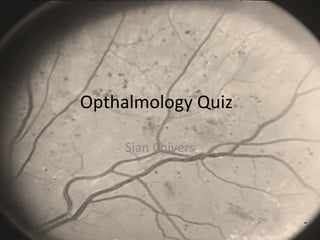
Opthalmology Quiz
- 2. Question 1 •What’s This? •Name 3 Causes? •What Symptoms may a person complain of? •How is it Treated
- 3. Answer 1 • Cataract • Causes – Senile (Commonest) – Diabetes, Recurrent Uveitis, Previous ocular surgery – Drugs – steroids, phenothiazines – Trauma and foreign bodies – Ionising radiation – Xray, UV – Congenital – Inherited – Myotonic Dystrophy, Marfan’s, Lowe’s, Rubella, high myopia • Symptoms – Reduced acuity, Glare in sunshine, Distortion of lines, Diplopia, Altered colours • Mydriatic drops, sunshades and sunglasses. Surgery – Phacoemulsification and Lens implant (US breaks up lens)
- 4. Question 2 •What is this? •What investigation is being carried out? •What is the causative organism? •What are the clinical features? •What is the treatment?
- 5. Answer 2 • Dendritic ulcer • Eye examination under fluorescein stain • Herpes Simplex virus • Irritable red eye, watering, photophobic • Refer to an opthalmologist, Aciclovir 3% eye ointment 5x daily
- 6. Question 3 •What is this? •Name 3 pathological features shown in the picture and describe how they occur? •Name 2 complications of this eye condition? •How can this eye condition be treated and what would you see when you looked at the retina post procedure?
- 7. Answer 4 • Background Diabetic retinopathy • Microaneurysms – outpouching of retinal caps Cotton wool spot – microinfarct of retinal nerve fibre layer Retinal oedema and exudate – leakage of serum into the neural retina and lipid accumulation Neovascularisation (proliferative) new vessels grow outside the retina along posterior surface of vitreous • Complications – blindness, vitreous haemorrhage and retinal detachment. Cataract as part of DM
- 8. Answer 4 Cont •Treatment •Good Glycaemic control prevents complications •Laser photocoagulation indicated for proliferative DR via argon laser •Vitrectomy – vitreous is removed via a trans-pars incision – to clear vitreous haemorrhage, to relieve retinal traction and to treat diffuse macular oedema
- 9. Question 5 •What abnormality is seen here? •Name 3 causes? •What may be seen when examining the pupils?
- 10. Answer 5 • Optic Atrophy • Causes – Hereditary – Autosomal dominant/recessive, Leber’s hereditary – Retinal Dystrophy – Cone Dystrophy, retinitis pigmentosa – Vascular – central retinal artery occlusion – Nutritional – VitB12 deficiency, tobacco, alcohol, drugs – ethambutol chloramphenicol – Inflammatory – Sarcoid, PAN – Demyelination (common) – Compressive (glioma or meningioma) • Relative afferent pupillary defect
- 11. Question 6 This patient has AIDS What is shown in fig 1 What organism cause this What other organisms commonly infect the retina of a patient with AIDS What is shown in fig 2 Would you expect lesions elsewhere What other infections affect the lids and conjunctiva of a patient with AIDS
- 12. Answer 6 • CMV retinitis • Millions – CMV, EBV, Toxoplasmosis, Syphilis, Cryptococcus, M.TB, M.aviumintracellulare, Candida, Aspergillus, histoplasmosis • Kaposi Sarcoma • Yes • Trichomegaly (long eyelashes), molluscum contagiosum, conjunctivitis, conjunctival granulomas , SCC assoc w HPV, herpes zoster opthalmitis
- 13. Question 7 •What intervention has been carried out here •What underlying condition does this patient have •What symptoms may the patient have experienced in the acute phase •What signs may have been apparent on examination •What is the treatment for the acute phase of the illness?
- 14. Answer 7 • A peripheral iridotomy • Glaucoma. Iridotomy is the intervention of choice to prevent angle closure glaucoma or after an attack has been broken by medical treatment • Symps – sudden onset, severely painful red eye, blurred vision, halos around lights, headache, nausea and vomiting • Signs – reduced visual acuity, brick red eye, hazy cornea, vertically mid-dilated fixed pupil, high IOP • Treatment – Pilocarpine 2-4% 2h, acetazolamide 500mg iv stat then 250mg/8h, mannitol 20% by ivi. Topical steroids and antihypertensive drops may be used
- 15. Question 8 •What is shown here? •What symptoms may the patient complain of? •What associated condition may the patient have •What signs are found on examination? •What is the management? •Complication?
- 16. Answer 8 • Anterior Uveitis • Painful red eye, photophobia, blurred vision or floaters • Autoimmune disease – ank spond, inflam bowel disease, sarcoidosis • Signs – ciliary injection, reduced visual acutiy, sluggish or irregular pupil, hazy iris details, high IOP • refer to opthalmologist, reducing regimen of topical steroid (dexamethosone 0.1%) and cycloplegic and dilating drops (cyclopentolate 1%) • Cataract in recurrent or chronic cases
- 19. Question 10 •Diagnosis •Signs •Main cause •Management •Diagnosis •Inherited underlying condition that may predispose •Other features of that condition
- 20. Answer 10 • Central retinal vein occlusion • Signs – afferent pupillary defect common, retinal haemorrhages, optic disc swelling, venous dilatation and tortuosity, cotton wool spots • Up to 33% are ischaemic assoc with rubeosis iridis or neovascularisation of disc • Detect any underlying systemic disease and treat, check IOP, screen for new vessels, treaat cv risk factors, laser new vessels. • Lens dislocation • Marfan’s syndrome • Aortic dissection or dilatation, dural ectasia, arachnodactly, armspan greater than height, pectus deformity, pes planus, scoliosis high arched palate, mitral valve prolapse, joint hypermobility.
- 21. Well done, that’s enough opthalmology for now!!